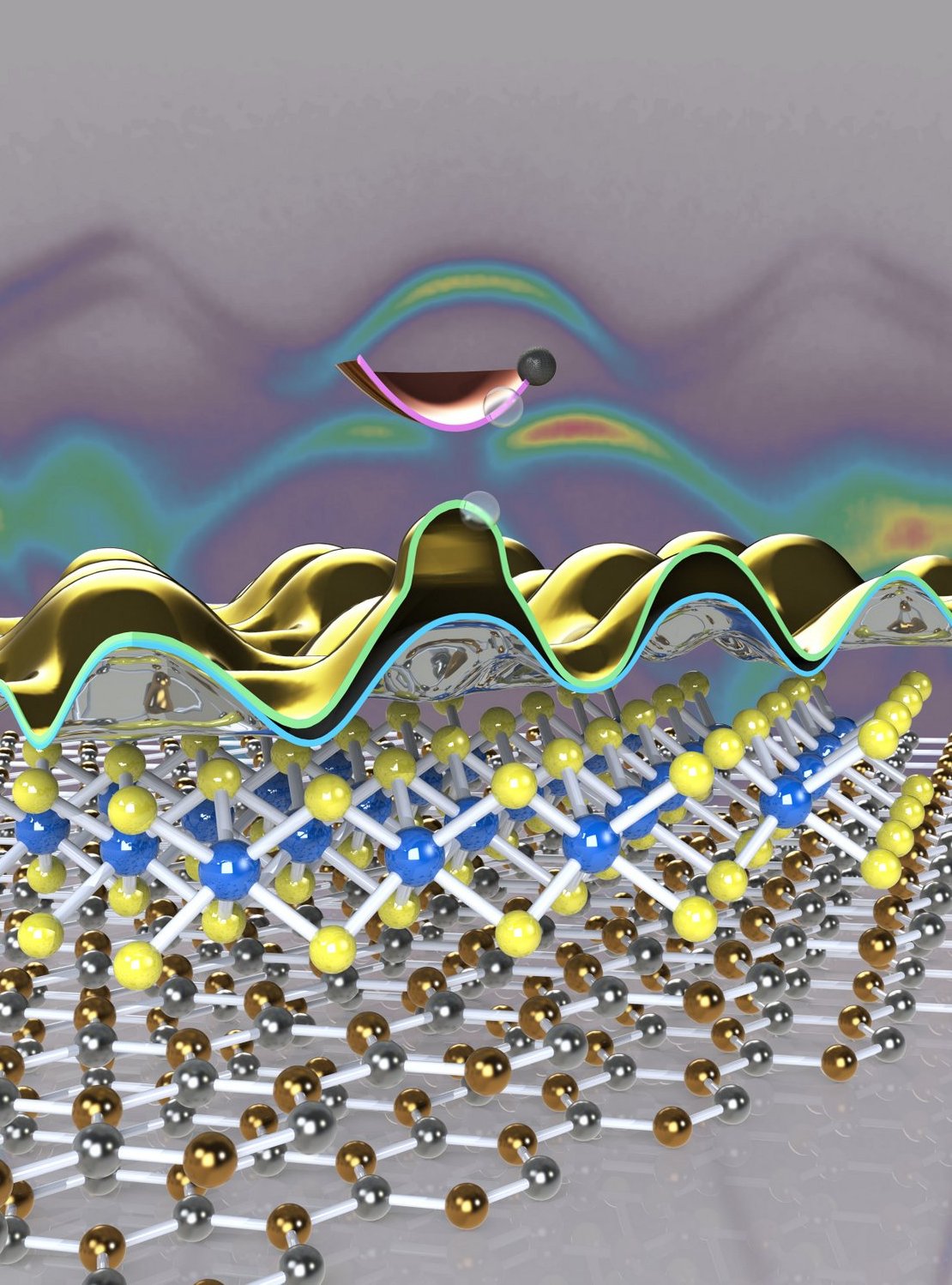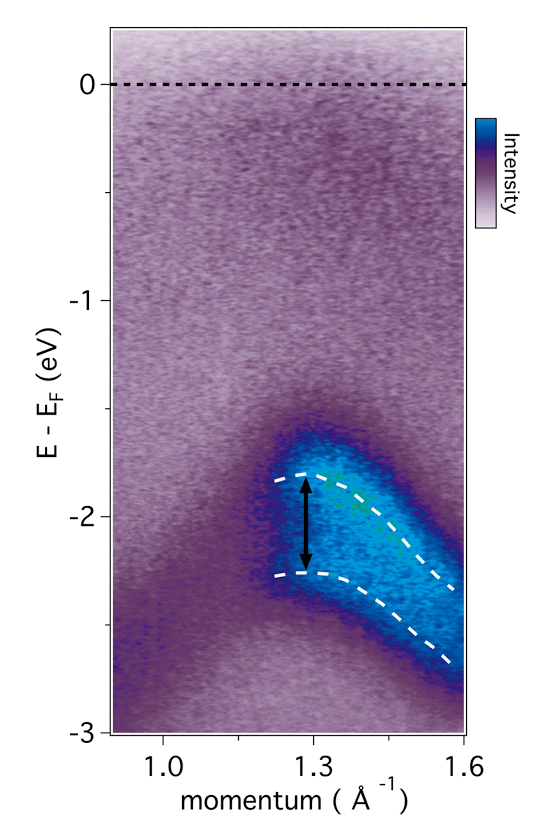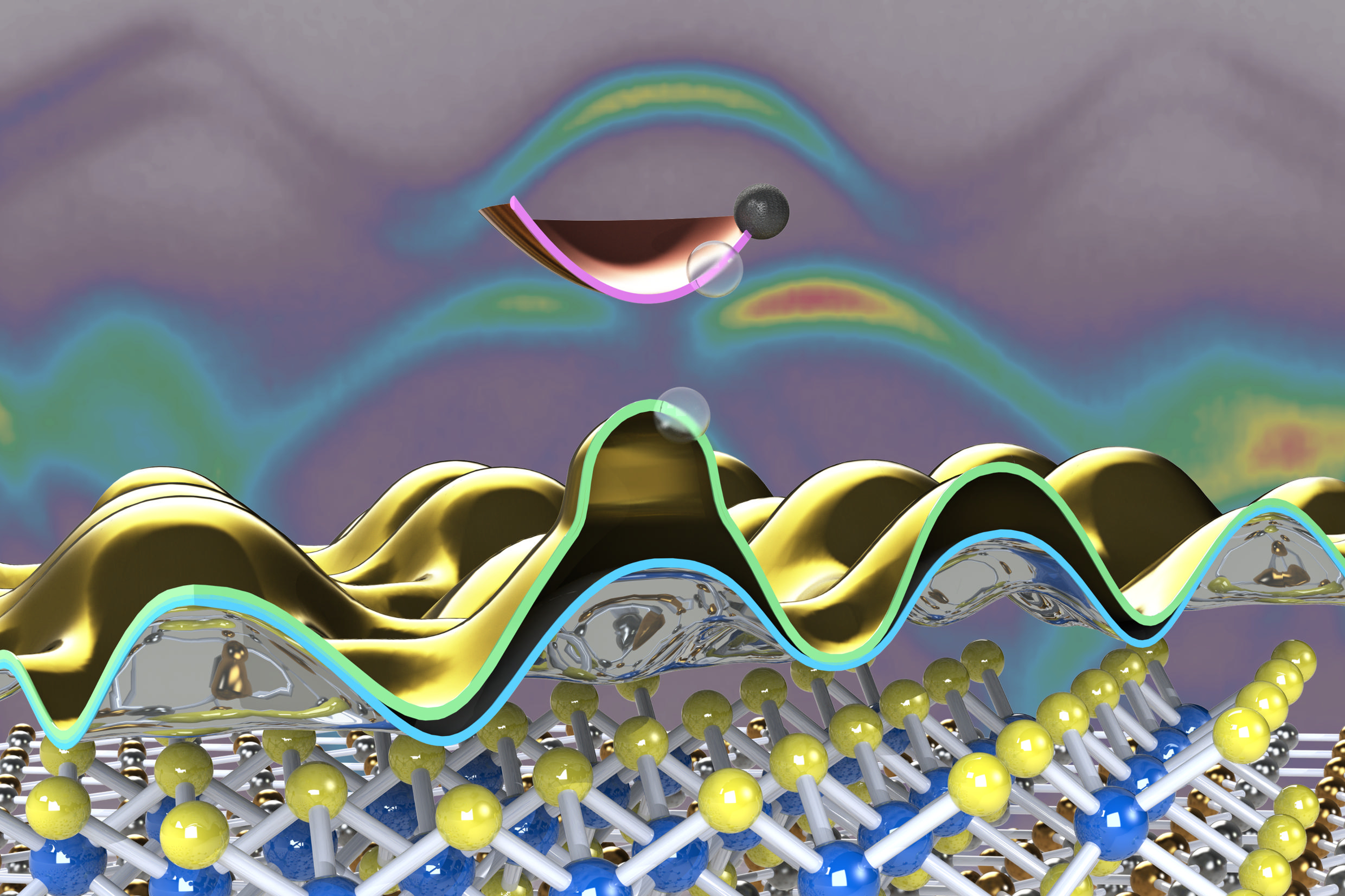
This rendering shows a “ball-and-stick” representation of the atomic structure of a 2-D single crystalline layer of tungsten disulfide (blue and yellow) on top of layers of 2-D boron nitride (silver and gold). On top of these is a representation of the structure of electronic energy levels, or valence bands, within the tungsten disulfide, and the increased splitting between the two valence bands observed using an x-ray technique at the MAESTRO beamline. The experiments suggest the effect could be due to “trions,” made up of two holes and an electron in the bands, depicted as clear and dark spheres. The background is raw data of the electronic structure of the tungsten disulfide, as measured in the experiment. (Credit: Chris Jozwiak/Berkeley Lab)
To see what is driving the exotic behavior in some atomically thin – or 2-D – materials, and find out what happens when they are stacked like Lego bricks in different combinations with other ultrathin materials, scientists want to observe their properties at the smallest possible scales.
Enter MAESTRO, a next-generation platform for X-ray experiments at the Advanced Light Source (ALS) at the Department of Energy’s Lawrence Berkeley National Laboratory (Berkeley Lab), that is providing new microscale views of this weird 2-D world.
In a study published Jan. 22 in the journal Nature Physics, researchers zeroed in on signatures of exotic behavior of electrons in a 2-D material with microscale resolution.
The new insights gleaned from these experiments show that the properties of the 2-D semiconductor material they studied, called tungsten disulfide (WS2), may be highly tunable, with possible applications for electronics and other forms of information storage, processing, and transfer.
Those applications could include next-gen devices spawned from emerging fields of research like spintronics, excitonics and valleytronics. In these fields, researchers seek to manipulate properties like momentum and energy levels in a material’s electrons and counterpart particles to more efficiently carry and store information – analogous to the flipping of ones and zeroes in conventional computer memory.
Spintronics, for example, relies on the control of an inherent property of electrons known as spin, rather than their charge; excitonics could multiply charge carriers in devices to improve efficiency in solar panels and LED lighting; and valleytronics would use separations in a material’s electronic structures as distinct pockets or “valleys” for storing information.
The signal they measured using MAESTRO (Microscopic and Electronic Structure Observatory) revealed a substantially increased splitting between two energy levels, or “bands,” associated with the material’s electronic structure. This increased splitting bodes well for its potential use in spintronics devices.
WS2 is already known to interact strongly with light, too. The new findings, coupled with its previously known properties, make it a promising candidate for optoelectronics, in which electronics can be used to control the release of light, and vice versa.
“These properties could be very exciting technologically,” said Chris Jozwiak, an ALS staff scientist who co-led the study. The latest research “in principle shows the ability to change these key properties with applied electric fields in a device.”
He added, “The ability to engineer the features of the electronic structures of this and other materials could be very useful in making some of these possibilities come true. We are right now at the brink of being able to study a huge variety of materials, and to measure their electronic behavior and study how these effects develop at even smaller scales.”

This animation shows a widening divide in the electronic bands of a 2-D material called tungsten disulfide as scientists “doped” the sample by introducing more electrons. Researchers hope to control this kind of increased splitting for new types of electronics applications. (Credit: Berkeley Lab)
The study also suggest that trions, which are exotic three-particle combinations of electrons and excitons (bound pairs of electrons and their oppositely charged counterpart “holes”), could explain the effects they measured in the 2-D material. Holes and electrons both serve as charge carriers in semiconductors found in popular electronic devices.
Researchers used a form of ARPES (angle-resolved photoemission spectroscopy) at the MAESTRO beamline to kick away electrons from samples with X-rays and learn about the samples’ electronic structure from the ejected electrons’ direction and energy. The technique can resolve how the electrons in the material interact with each other.
“There are very few direct observations of a particle interacting with two or more other particles,” said Eli Rotenberg, a senior staff scientist at ALS who conceptualized MAESTRO more than a decade ago. It was built with the goal to directly observe such “many-body” interactions in detail not possible before, he said. “This is what we were going for when we built the MAESTRO beamline.”
MAESTRO, which opened to scientists in 2016, also features several stations that allow researchers to fabricate and manipulate samples for X-ray studies while maintaining pristine conditions that protect them from contamination. MAESTRO is one among dozens of X-ray beamlines at the ALS that are specialized for samples ranging from proteins and vaccines to batteries and meteorites.
In addition to MAESTRO’s precise measurements, the careful preparation of the tungsten disfulfide flakes in sufficient size for study, and their transfer to a base material (substrate) that didn’t impede their electronic properties or obstruct the X-ray measurements were also vital in the success of the latest study, Jozwiak noted.
Jyoti Katoch, the study’s lead author and a research scientist at The Ohio State University, said, “Two-dimensional materials are extremely sensitive to their surroundings, so it’s imperative to fully understand the role of any outside disturbances that affect their properties.”
Katoch worked with Roland Kawakami, a physics professor at Ohio State, in preparing the samples and designing the experiment. They coupled samples of WS2 to boron nitride, which provided a stable, non-interacting platform that was crucial for the X-ray measurements. Then they used a metal as an “external knob” to modify the properties of the WS2.
“This study enables two critical breakthroughs: it provides a clear fundamental understanding of how to remove outside effects when measuring the intrinsic properties of 2-D materials, and it allows us to tune the properties of 2-D materials by simply modifying their environment.”
Søren Ulstrup, an assistant professor at Aarhus University who had worked on the WS2 MAESTRO experiments as a postdoctoral researcher, added, “Seeing the intrinsic electronic properties of the WS2 samples was an important step, but perhaps the biggest surprise of this study emerged when we started to increase the number of electrons in the system – a process called doping.
“This lead to the dramatic change of the splitting in the band structure of WS2,” he said, which suggests the presence of trions.

This schematic shows the experimental stations at MAESTRO, a beamline at Berkeley Lab’s Advanced Light Source. (Credit: Berkeley Lab)
MAESTRO can handle very small sample sizes, on the order of tens of microns, noted Rotenberg, which is also a key in studying this and other 2-D materials. “There’s a big push to resolve materials’ properties on smaller and smaller scales,” he said, to better understand the fundamental properties of 2-D materials, and scientists are now working to push MAESTRO’s capabilities to study even smaller features – down to the nanoscale.
There is accelerating R&D into stacking 2-D layers to tailor their properties for specialized applications, Jozwiak said, and MAESTRO is well-suited to measuring the electronic properties of these stacked materials, too.
“We can see a very explicit impact on properties by combining two materials, and we can see how these effects change when we change which materials we’re combining,” he said.
“There is an endless array of possibilities in this world of ‘2-D Legos,’ and now we have another window into these fascinating behaviors.”
The Advanced Light Source is a DOE Office of Science User Facility.
Researchers from the U.S. Naval Research Laboratory, Ohio State University, and Aarhus University in Denmark also participated in the study. Samples used in the study were fabricated at the U.S. Naval Research Laboratory and prepped for experiments at Ohio State University.
The work was supported by the U.S. Department of Energy’s Office of Basic Energy Sciences, the Danish Council for Independent Research, VILLUM FONDEN, the Swiss National Science Foundation, the National Science Foundation, the U.S. Naval Research Laboratory Nanoscience Institute, and the U.S. Air Force Office of Scientific Research.
More:
- Learn about the MAESTRO beamline at Berkeley Lab’s Advanced Light Source.
- View a related press release by Aarhus University (Danish).
###
Lawrence Berkeley National Laboratory addresses the world’s most urgent scientific challenges by advancing sustainable energy, protecting human health, creating new materials, and revealing the origin and fate of the universe. Founded in 1931, Berkeley Lab’s scientific expertise has been recognized with 13 Nobel Prizes. The University of California manages Berkeley Lab for the U.S. Department of Energy’s Office of Science. For more, visit www.lbl.gov.
DOE’s Office of Science is the single largest supporter of basic research in the physical sciences in the United States, and is working to address some of the most pressing challenges of our time. For more information, please visit science.energy.gov.
